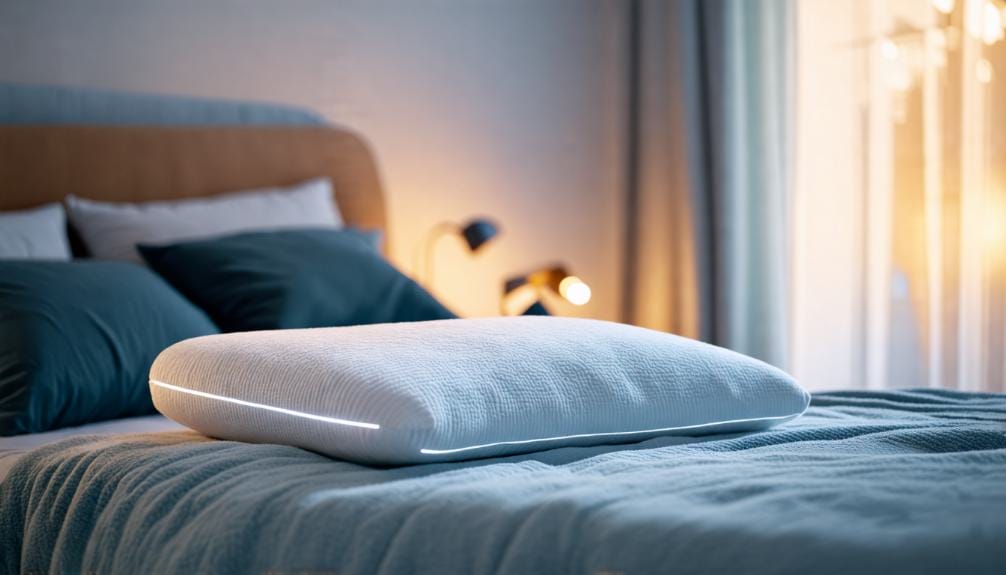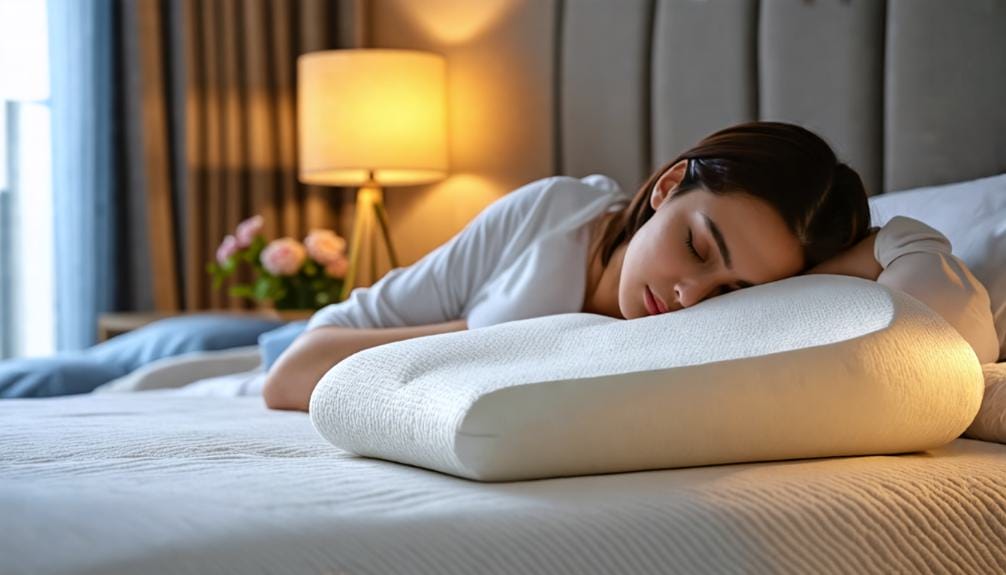How To Sleep On A Contour Pillow? The Ultimate Guide
Upon your initial use of a contour pillow, it’s crucial to comprehend how to position yourself for optimal benefit. You’ll want to align your neck with the pillow’s contours to guarantee proper support, whether you sleep on your back or side. Selecting the appropriate firmness is also vital, as it can greatly influence your comfort and spinal alignment. But what occurs if you still experience discomfort despite making these adjustments? There’s more to it than just positioning; let’s explore other factors that could be affecting your sleep quality.
What is a contour pillow?

A contour pillow has a distinct design with different heights that specifically supports your neck and head during sleep.
This design promotes proper spinal alignment and helps reduce discomfort.
Design features
Contour pillows are designed with a distinct shape that features two different heights, making them suitable for various sleeping positions. This specific design helps maintain proper spinal alignment, which is crucial for improving sleep quality. Typically crafted from memory foam, these pillows mold to the shape of your neck and head, providing support throughout the night.
Key design features of a contour pillow include:
- Dual Heights: One side is elevated for back sleepers, while the opposite side is lower for side sleepers, accommodating individual preferences.
- Curved Design: The contour hugs the neck, offering targeted support that minimizes strain on the spine.
- Quality Material: Memory foam is durable and adapts to the body’s shape, providing comfort and support.
These features work together to promote better sleep and overall comfort, making contour pillows an excellent choice for those seeking restful nights.
Benefits for sleep quality
Using a contour pillow can significantly affect your sleep quality by offering personalized support that matches the natural contours of your body. These pillows are specifically crafted to promote proper spinal alignment, which is crucial for both back and side sleepers. By utilizing a contour pillow, you provide your neck and head with the necessary support, which can alleviate discomfort and encourage a more restful night’s sleep.
Here’s a clear overview of the benefits for different sleeping positions:
| Feature | Back Sleepers | Side Sleepers |
|---|---|---|
| Support Type | Larger hump cradles the neck | Smaller hump supports the head |
| Spinal Alignment | Maintains the natural cervical curve | Ensures the spine stays aligned from head to tail |
| Discomfort Relief | Reduces stiffness and pain | Alleviates shoulder and neck strain |
| Sleep Quality Impact | Promotes deeper sleep cycles | Encourages better rest and recovery |
Incorporating a contour pillow into your sleep routine can lead to more restorative sleep, making it easier to wake up feeling refreshed and ready for the day.
How to use a contour pillow effectively?
To use a contour pillow effectively, consider your sleeping position.
For back sleepers, place your neck on the larger hump for optimal support.
If you sleep on your side, use the smaller hump to keep your spine aligned and reduce neck strain.
For back sleepers
For back sleepers, positioning your neck on the higher contour of the pillow is crucial for supporting the natural curve of your cervical spine. This alignment helps maintain spinal health and ensures comfort throughout the night.
Here are practical tips for using your contour memory foam pillow effectively:
- Select the right firmness: Verify that your contour pillow provides adequate support for your neck and head. The right firmness can prevent strain and promote comfort.
- Adjust your mattress: A sturdy mattress works hand-in-hand with your contour pillow, creating a stable foundation that supports your spine’s alignment.
- Experiment with your position: Minor changes in your pillow placement can significantly affect your comfort level. Try different angles to find what works best for you.
For side sleepers
As a side sleeper, using the smaller hump of a contour pillow is essential for providing optimal neck support and keeping your spine in a straight alignment. This setup minimizes strain on your neck and shoulders, allowing your body to settle into a more natural and relaxed position.
It’s important to allow your shoulders to sink into the mattress, which reduces pressure on sensitive areas, especially around the neck.
For a more restful sleep, pay attention to your arm placement. Position your bottom arm beneath your body and keep your top arm relaxed. This arrangement helps avoid extra strain on your shoulders and neck.
If you notice that your hips feel out of alignment, placing a small pillow between your knees can help maintain proper posture and minimize discomfort throughout the night.
If you’re trying a contour pillow for the first time, it might feel unusual at first. Give your body a little time to adapt. Over time, using this type of pillow can lead to better sleep quality.
The aim is to wake up feeling refreshed and free from any aches. By correctly positioning yourself with the contour pillow, you not only increase comfort but also support your overall sleep health.
Make the most of this supportive tool to enjoy the benefits of a well-aligned spine while you rest.
Why does my neck hurt on a contour pillow?

If you’re waking up with neck pain after using a contour pillow, a few common factors may be at play.
You might be going through an adjustment period as your body adapts to the new support and shape.
Improper positioning can also cause discomfort, so check that you’re using the correct height for your sleeping style.
Common causes of discomfort
Neck pain associated with a contour pillow often arises from misalignment or failure to adapt to its specific design. If you’re feeling discomfort during sleep, consider the following common issues:
- Improper Height: Using the wrong side of the pillow can create neck strain. It’s important to rest your head on the right contour that matches your sleeping style to maintain proper alignment.
- Unsuitable Sleep Position: Sleeping on your stomach may not allow the contour pillow to offer the necessary support, potentially leading to neck discomfort.
- Alignment Techniques: Not adjusting your pillow correctly or failing to keep your spine aligned can cause pain. Aim for a straight line from your head through your spine for optimal support.
Addressing these factors can significantly improve your sleep quality and reduce neck pain.
Adjustment period
Switching to a contour pillow usually involves an adjustment period, where you might feel some neck discomfort as your body adapts to its specific shape. This discomfort is a normal response as your muscles and spine realign with the pillow’s design. It’s important to be patient during this time.
Here’s what you may encounter during the adjustment:
| Stage of Adjustment | Signs of Discomfort |
|---|---|
| Initial Change | Neck stiffness, soreness |
| Mid-Adjustment | Occasional discomfort during sleep |
| Final Adjustment | Better sleep quality |
Throughout this adjustment phase, the contour pillow offers support tailored to your sleeping position. Back sleepers benefit from the larger hump that aligns the neck, while side sleepers find relief with the smaller hump. As your body gets used to the pillow, you should notice an improvement in sleep quality and a reduction in discomfort.
Allow yourself several nights—or even weeks—before deciding if the pillow isn’t suitable. Adapting to a contour pillow can significantly lead to more restful nights and refreshed mornings, so be patient as your body acclimates!
How to maintain sleep hygiene with a contour pillow?
To keep your contour pillow clean and hygienic, follow a regular washing routine.
Spot clean any stains quickly and wash the pillowcase often to avoid allergen buildup.
Always check the care instructions for your specific pillow to make sure you’re cleaning it correctly for long-lasting support.
Cleaning tips
Cleaning your contour pillow is crucial for keeping your sleep environment hygienic and comfortable. Over time, pillows can gather dust mites, perspiration, and skin oils, which can disrupt your sleep quality.
Follow these practical cleaning tips to keep your pillow fresh:
- Spot Clean: For small stains, use a cloth moistened with soapy water. Avoid soaking the pillow to help it retain its shape.
- Rinse: After spot cleaning, use a clean cloth dampened with water to wipe away any soap residue from the surface.
- Air Dry: Allow your pillow to dry completely in the air before using it again. This helps prevent mildew and keeps your pillow clean.
Pillow care
To keep your contour pillow in top shape and ensure a clean sleeping environment, follow these straightforward care tips.
Regularly clean your memory foam pillow to prevent the buildup of dirt and allergens. Most pillows can be spot cleaned with a mild detergent and a damp cloth, but always check the manufacturer’s guidelines. Avoid soaking the pillow since excessive moisture can damage the foam.
Using a pillow protector is essential. It acts as a barrier against sweat, dust mites, and allergens, which can contribute to discomfort and health issues. Regularly washing the protector—every few weeks—will help maintain a hygienic sleep surface.
Rotate your pillow from time to time. This simple step promotes even wear and maintains the pillow’s shape and support, allowing for consistent comfort throughout the night.
Also, air out your pillow periodically. Memory foam can retain odors, and giving it a chance to breathe can help eliminate unwanted smells.
What are the best sleeping positions for a contour pillow?

Sleeping position is important for using a contour pillow effectively.
Side sleepers should rest their head on the smaller hump to keep the spine aligned.
Back sleepers will benefit from the larger hump for better support.
Stomach sleepers should consider changing their position, as this can put strain on the neck.
Side sleeping
Side sleeping benefits significantly from the use of a contour pillow, which is designed to support the natural curve of your head and neck. This alignment plays a crucial role in maintaining spinal health and can lead to better sleep quality.
Here are practical tips to maximize your comfort while side sleeping:
- Utilize the smaller hump: Position your head on the contour pillow’s smaller side to keep your neck aligned with your spine.
- Relax your shoulders: Allow your shoulders to sink into the mattress, helping to prevent neck strain.
- Add a knee pillow: Placing a pillow between your knees promotes proper hip alignment and alleviates pressure on the lower back.
These adjustments can create a more restful and supportive side sleeping experience.
Back sleeping
For back sleepers, using a contour pillow is essential for supporting the natural curve of your spine. Position your neck on the larger part of the pillow to maintain a neutral spine alignment. This setup helps prevent stiffness and discomfort upon waking.
Proper alignment is also beneficial for those experiencing sleep apnea. A well-placed head and neck can keep airways open, allowing for better airflow during sleep. Avoid tilting your head too far forward or back, as this can disrupt alignment and create tension in your neck and shoulders.
Adjusting the height of your pillow can significantly impact your comfort. Try different angles until you find the position that best supports your neck and spine.
It may take a few nights to adapt to the contour pillow, but the result often includes deeper sleep and reduced morning discomfort. Focusing on spinal health while sleeping on your back can lead to a more restful and restorative sleep experience.
Stomach sleeping
Stomach sleeping presents specific challenges that require careful pillow selection to alleviate strain on the neck and spine. For stomach sleepers, using the right pillow is crucial to prevent discomfort and promote proper alignment. Here are practical strategies to enhance your sleeping experience:
- Choose a low-profile pillow: A thinner contour pillow keeps your neck in line with your spine, reducing potential strain.
- Adjust your head position: Rotating your head to one side can help relieve pressure on your neck. However, be mindful of how long you maintain that position to avoid stiffness.
- Select a soft pillowcase: A smooth, soft pillowcase enhances comfort and minimizes friction against your skin during sleep.
Following these guidelines can lead to a more restful night’s sleep for stomach sleepers, promoting better overall health and comfort.
Frequently Asked Questions
Can I Use a Contour Pillow With a Regular Pillowcase?
Yes, you can use a contour pillow with a regular pillowcase. Just make sure it fits snugly to maintain support. If it’s too loose, consider a case specifically designed for contour pillows for ideal comfort.
How Long Does It Take to Adjust to a Contour Pillow?
It usually takes you a few nights to adjust to a contour pillow. Your body needs time to adapt to its shape, so be patient; you’ll likely notice improved comfort and sleep quality soon.
Are Contour Pillows Suitable for Stomach Sleepers?
Contour pillows aren’t usually ideal for stomach sleepers. They can elevate your head too much, straining your neck. If you sleep this way, you might prefer a flatter pillow for better alignment and comfort.
What Materials Are Contour Pillows Typically Made From?
Contour pillows are typically made from memory foam, latex, or gel-infused materials. Each option offers varying levels of support and temperature regulation, helping you find the perfect balance for a comfortable night’s sleep.
Can Contour Pillows Help With Snoring Issues?
Yes, contour pillows can help with snoring issues. By promoting proper spinal alignment and keeping your airways open, they reduce the likelihood of airway obstruction, which often contributes to snoring. You’ll likely notice a difference.
In Conclusion
To summarize, using a contour pillow can greatly enhance your sleep quality as you align it with your sleeping position.
Whether you’re a back or side sleeper, finding the right firmness and adjusting your mattress are key steps for comfort.
If you experience neck pain, reassess your positioning and give yourself time to adjust.
By maintaining good sleep hygiene, you’ll maximize the benefits of your contour pillow and wake up refreshed and ready to tackle the day!
